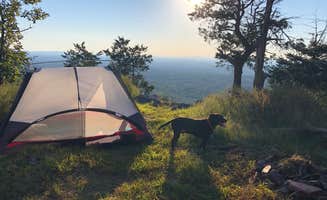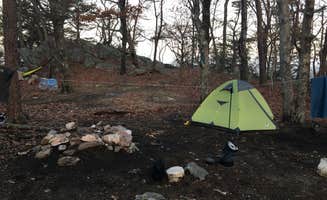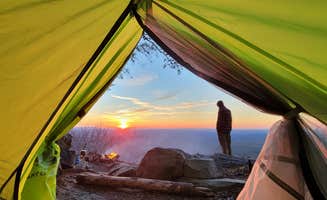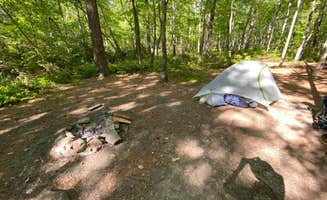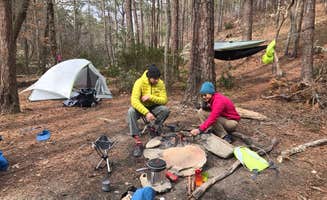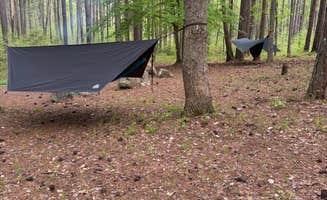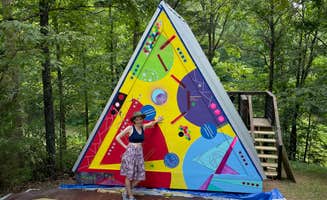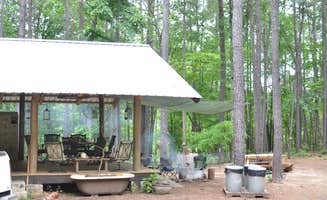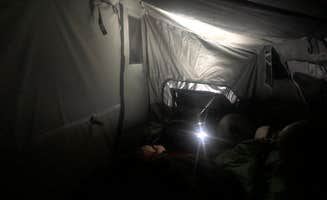Tent campsites near Anniston, Alabama offer accessible wilderness experiences within Talladega National Forest at elevations ranging from 650 to 2,400 feet. The forest's longleaf pine ecosystem provides habitat for diverse wildlife including white-tailed deer, wild turkeys, and numerous bird species. Camping access roads are typically unpaved but passable for standard vehicles, with most primitive sites located between 1-2 miles from trailheads.
What to do
Swimming in natural pools: The backcountry sites along Chinnabee Silent Trail provide access to multiple swimming areas. At Chinnabee Silent Trail Backcountry Site 9, you'll find "the big swimming hole 'devils den' about 1/2 a mile from the chinnabee lake parking area," according to Justin C.
Hiking the Pinhoti: This major trail system offers routes for all skill levels. Nicolas B. notes the section near Pinhoti Trail Backcountry Campground is "not very rocky or mountainous" with "parking available near the railroad tracks," making it accessible for beginners.
Wildlife watching: Spring through early summer provides optimal wildlife viewing. Visiting Talladega National Forest in spring, Asher K. observed "so many birds and even found a nest that was built in a bush along the trail" during a hike near Cheaha Falls.
Stargazing: Clear nights offer excellent star visibility due to minimal light pollution. Nancy C. described her experience at McDill Point: "After building a fire, making dinner and roasting marshmallows, we sat to enjoy the most beautiful sunset and then the stars emerging into a brilliant light show."
What campers like
Budget-friendly camping: At $5 per night, primitive camping in the area is highly affordable. Jeremy M. calls Turnipseed Campground "the best bang for your buck I've seen yet!!! It is first come first serve tho but there's about 10 or so campsites too choose from."
Reliable water sources: Most backcountry sites near water features maintain flow even in dry periods. Campers at Chinnabee Silent Trail Backcountry Site 9 mention the site "has a nice established fire pit and easy access to water for purifying."
Privacy between sites: Even at established campgrounds, sites are well-spaced. Alinda S. found Turnipseed Campground "very peaceful and quite and relaxing... We are the only 1s up here for the time being but there's some good walking trails that we hiked on was easy to make a hot meal with the fire ring."
Diverse site options: The area offers everything from drive-up sites to backcountry experiences. Rachel K. notes that Turnipseed has "Only about a dozen sites, most to partial shade (it's in the forest), plenty of downed pine not far. Sites are positioned well and decent for tent or something like a motorcycle camper."
What you should know
Seasonal closures: Many recreation areas operate March through December only. During off-season months, gates may be locked, requiring additional hiking to reach trails.
Limited facilities: Most primitive sites have minimal infrastructure. Peg W. explains that at Turnipseed Campground "It's very nice to just drop five dollars in a box and go camp there are no attendants here. There is no running water or showers but there is an outhouse."
Water planning: Bring sufficient water or purification equipment. Lynn G. emphasizes that at Blue Mountain Shelter and surrounding trails, "there is a ton of diversity in this area, including lovely plants, geology, animals, and deep almost completely undisturbed wilderness" but water access can be limited.
Variable weather: The region experiences quick weather changes, particularly in spring. Nancy C. described her overnight at McDill Point: "The wind was howling, so after the fire burned out, we hit the hay. Overnight, the clouds, fog and gentle misting rain rolled in, obscuring the view."
Tips for camping with families
Short hike options: Several sites require minimal hiking, suitable for children. The McDill Point trail from Cheaha trailhead is "about a 2 mile trip and can take anywhere from 1 to 1.5 hours," making it manageable for families with older children.
Educational opportunities: The area offers rich learning experiences about forest ecosystems. Lynn G. recommends at Cheaha Falls Private Backcountry Campsite to "explore as many trails as you can, especially the Pinhoti trail. There is a ton of diversity in this area, including lovely plants, geology, animals, and deep almost completely undisturbed wilderness."
Beginner-friendly backpacking: Several sites make good first backpacking trips. Asher K. describes McDill Point as "a good starter backpacking trip with a great camping site and amazing views."
Historical sites: Aviation history enthusiasts can explore crash sites. Nancy C. shares: "Just past McDill, there is a side trail that takes you to debris from a 1972 plane crash site."
Tips from RVers
Size limitations: Most forest roads and campgrounds cannot accommodate large rigs. Asher K. notes that Blue Mountain Shelter is accessible via trails that begin at Cheaha Trailhead on 281, but the primitive nature means "Most of the camping along the Pinhoti is classic semi-flat backcountry sites with a small fire pit and not much else."
Alternative options: Small RVs and vans can utilize certain areas. Ro J. suggests Cheaha Falls Campground is "Best for tent and van camping. Maybe a tiny RV," noting they stayed April 25-28 when "During Thursday and Friday it was mostly empty. Saturday night it was half full."
Day-use alternatives: RV owners can base at developed campgrounds and day-hike to primitive areas. Colben F. observed that Turnipseed is "very cheap though. Where else could you stay for $5 a night other than backcountry?" but wouldn't "recommend this campground to anyone in a large RV."


